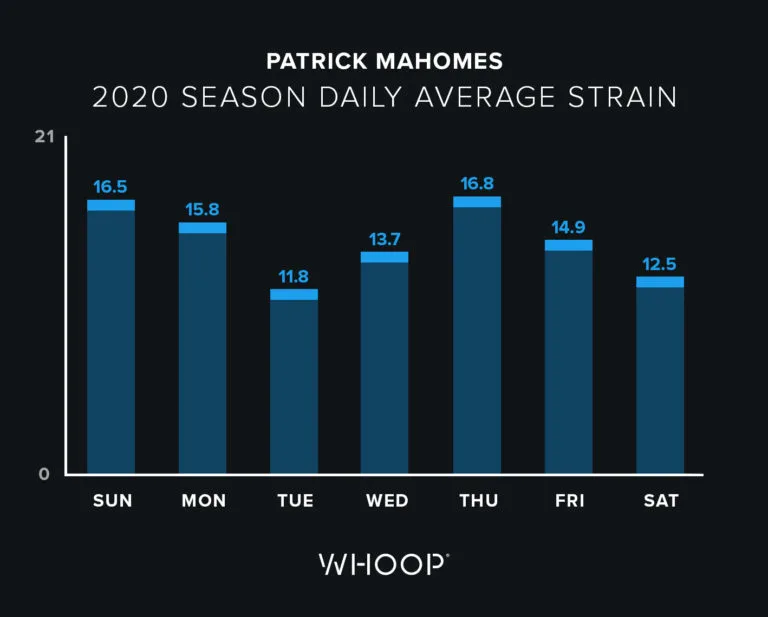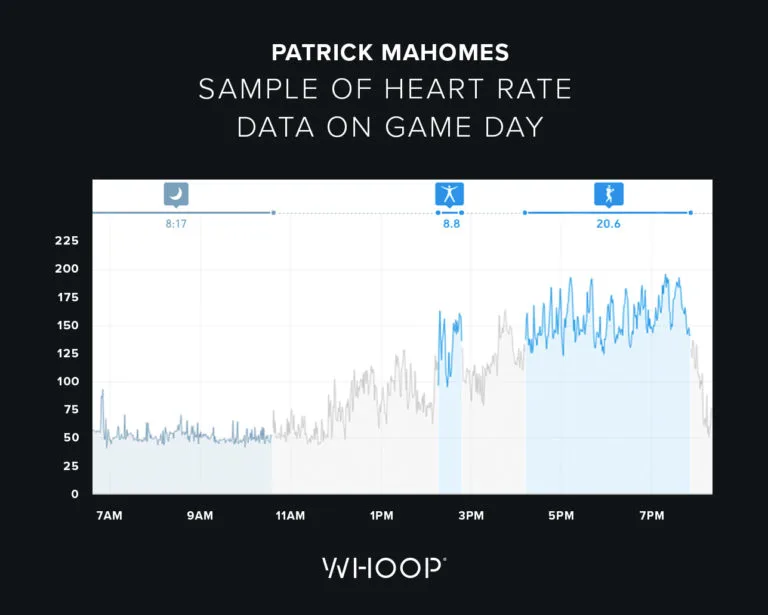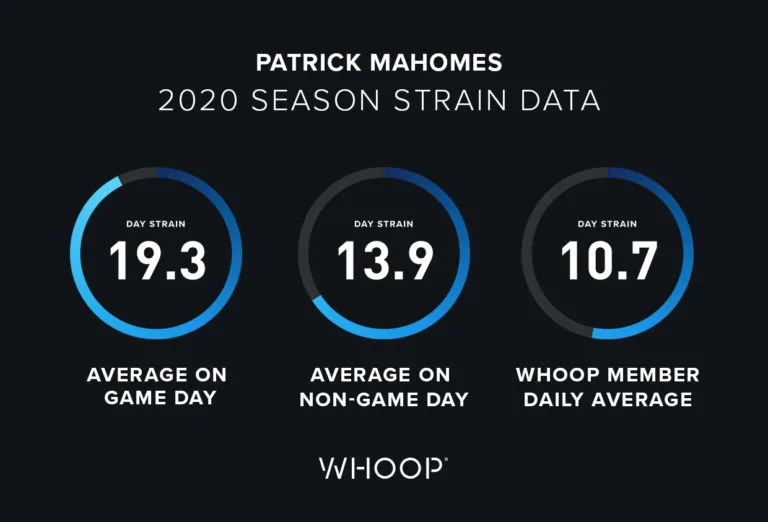Topics
- Article
- Training & Exercise
- Member Stories
Patrick Mahomes’ WHOOP Data: Quantifying the Strain of an NFL Season

With the 2021 NFL season only a few months away, we take a look back at last year and the biometric data of the league’s biggest star, Patrick Mahomes.
What impact does an NFL game have on the human body? Is there a cumulative effect as the football season wears on? How do players balance training and recovery in order to peak on game day? We try to answer these questions and many more as we explore some of Patrick Mahomes’ WHOOP data from the 2020 NFL season.
Season Highs in Recovery, Strain & Sleep
The three pillars of WHOOP are recovery (how ready your body is to perform from 0-100%), strain (cardiovascular exertion on a 0-21 scale), and sleep. From the season-opening kickoff on September 10, 2020, through the Super Bowl on February 7, 2021, here are Mahomes’ highest daily numbers for each:

Patrick Mahomes' highest recovery, strain and sleep tracked by WHOOP during the 2020 NFL season.
“Checking my recovery score is the first thing I do when I wake up,” Patrick said on an upcoming episode of the WHOOP Podcast. “I look at it because I want to know how I’m feeling, how my body is feeling, where I’m at. Usually if I’m feeling pretty relaxed it’s a pretty good score.”
What a Typical Week Looks Like
With Sundays normally being game days, there are distinct patterns that emerge from week to week in a player’s training load. Mahomes played in 14 games on Sundays, three on Mondays and one on a Thursday (he sat out one Sunday as well). To no surprise, Sundays were a very high-strain day for him (16.5 on average). Also quite predictable, Mondays were his lowest average recovery day by far, at just 45.7%. Below is a chart depicting Mahomes’ average strain for each day of the week:

The average WHOOP strain Patrick Mahomes took on By day of the week during the 2020 season.
The 15.8 average strain on Mondays might be unexpected, but is understandable given the effects of three games, plus the fact that strain accumulates faster when your body is under-recovered. Basically, his workouts had a greater cardiovascular impact those days as his body was less capable than usual of taking on stress. Additionally, Mahomes’ personal coach Bobby Stroupe told us that on Mondays they often did strength training with high aerobic output in order to “flush out the toxins” and reset for the week ahead. Tuesdays were clearly a day to “rest” (although it’s hard to categorize an 11.8 strain as “rest,” more on this later), and Mahomes’ team typically did not practice. Stroupe noted that “Kansas City has some of the hardest practices in the NFL on Thursdays every week. They simulate a lot of game-type situations, and that’s why you’re seeing a lot of high strain those days.” He also pointed out that Mahomes practices just like he plays, giving it his all. It falls in line that Saturday would be one of Mahomes’ lowest-strain days, as he aims to get his body prepared for Sunday. “He’s literally one of the most active players in pro sports,” Stroupe added. “I’m making changes on my end from a volume standpoint based on his strain scores from week to week.”
Intensity of Game Day: Heart Rate and Strain Data
What follows is an example of Mahomes’ heart rate data (including sleep and strain from activities) over the course of a typical game day:

A sample of Patrick Mahomes' WHOOP heart rate data on the day of a game.
You can see that beginning about 90 minutes before kickoff, his HR rarely dips below 125 beats per minute. And from the time the game starts, it stays fairly steady in the 150-190 range (with a brief dip at halftime). Mahomes’ total day strain on this particular Sunday was 20.7 (the more strain you take on the harder it is to build, so day strain does not equal the sum of strain from activities). For context, athletes who run a marathon or compete in an Ironman triathlon often have strains of 20.7 that day--but nobody runs a marathon every weekend for five straight months. Spanning the entire season, Mahomes’ average strain during games was 16.7, with his overall day strain on game days averaging 19.3.

Comparing Patrick Mahomes' average WHOOP strain on game days vs. All others in season, as well what's normal for most people.
Grind of the NFL Season
Amazingly, Mahomes’ average strain on non-game days was still 13.9. To put that in perspective, the average day strain for all WHOOP members last year was only 10.7 (see graphic above). The key point to keep in mind here is that WHOOP strain is relative to each individual, so the argument that he's a world-class athlete who can take on more doesn't apply. Anything 14 and above is considered fairly strenuous regardless of who you are, and he averaged that for the entire season (on his “off” days no less). Every human body needs rest, and from September through February Mahomes performed at an elite level while operating like a machine. Here’s a glimpse at his rolling 10-day strain average for the entire season:

The 10-day rolling average of Patrick Mahomes' WHOOP strain spanning the 2020 NFL season.
Viewing a 10-day average smoothes out the data and eliminates a lot of day-to-day fluctuation so trends can better stand out. Mahomes’ strain really elevated in late October and November and then basically stayed that way for the remainder of the season. The dip in mid-November reflects a bye week that month, and the drop in January follows back-to-back weeks without playing. “It does make so much sense,” Mahomes said when seeing how his strain built as the season progressed. “Obviously every game is important, but September and October you’re feeling out what you are as a team. As you get to November and December and obviously January and February, your intensity picks up as you’re trying to win these football games.”
Green Recovery & Best Game of the Year
On Sunday November 1st, before he really started taking on intense levels of strain from the grueling demands of the long season, Mahomes woke up with a 91% WHOOP recovery. His body was primed to perform, and it showed. That afternoon, he completed 31 of 42 passes for 416 yards and a season-high 5 touchdown passes. He also posted a passer rating of 144.4, his best of the year.
What Causes the Most Strain?
Looking through Mahomes’ most strenuous days of the season and comparing them to his in-game stats, there was a noticeable correlation between his number of pass attempts and high strain. For a quarterback who makes every effort to move all over the field and find the ideal target, this makes perfect sense:
- September 9th - 47 pass attempts (2nd highest total of season) in overtime win, 20.7 day strain
- November 29th - 49 attempts in victory over Tampa Bay, 20.6 day strain
- February 7th - 49 attempts in Super Bowl, 20.7 day strain
Interestingly enough, both of Mahomes’ highs in pass attempts this past season came against Tampa Bay. Also worth noting from the Super Bowl (in which he had a 20.5 activity strain), Mahomes set a record for quarterbacks for the year by running 497 yards before throws or sacks. It’s no wonder he pushed his body to the max that day. Learn More: NFLPA Provides WHOOP to All Active NFL Players